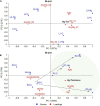Flavonoid Accumulation Varies in Medicago truncatula in Response to Mercury Stress
- PMID: 35874019
- PMCID: PMC9301243
- DOI: 10.3389/fpls.2022.933209
Flavonoid Accumulation Varies in Medicago truncatula in Response to Mercury Stress
Abstract
Mercury (Hg) contamination is increasing worldwide in both wild ecosystems and agricultural soils due to natural processes, but mostly to anthropic activities. The molecular mechanisms involved in Hg toxicity and tolerance in plants have been extensively studied; however, the role of flavonoids in response to Hg stress remains to be investigated. We conducted a metabolomic study to analyze the changes induced at the secondary metabolite level in three Hg-tolerant and one Hg-sensitive Medicago truncatula cultivars. A total of 46 flavonoid compounds, classified into five different flavonoid families: anthocyanidins, flavones, isoflavones, pterocarpan flavonoids, and flavanones, along with their respective glycoconjugate derivatives, were identified in leaf and root tissues. The synthesis of free isoflavones, followed by monoglycosylation and further malonylation was shown to be characteristic of root samples, whereas higher glycosylation, followed by further acylation with coumaric and ferulic acid was characteristic of leaf tissues. While minor changes were observed in leaves, significant quantitative changes could be observed in roots upon Hg treatment. Some flavonoids were strongly upregulated in roots, including malonylglucosides of biochanin A, formononetin and medicarpin, and aglycones biochanin, daidzein, and irisolidone. Hg tolerance appeared to be mainly associated to the accumulation of formononetin MalGlc, tricin GlcAGlcA, and afrormosin Glc II in leaves, whereas aglycone accumulation was associated with tolerance to Hg stress in roots. The results evidence the alteration of the flavonoid metabolic profile and their glycosylation processes in response to Hg stress. However, notable differences existed between varieties, both in the basal metabolic profile and in the response to treatment with Hg. Overall, we observed an increase in flavonoid production in response to Hg stress, and Hg tolerance appeared to be associated to a characteristic glycosylation pattern in roots, associated with the accumulation of aglycones and monoglycosylated flavonoids. The findings are discussed in the context of the flavonoid biosynthetic pathway to provide a better understanding of the role of these secondary metabolites in the response and tolerance to Hg stress in M. truncatula.
Keywords: LC-QTOF; Medicago truncatula; flavonoids; heavy metal stress; mercury; metabolomics.
Copyright © 2022 Alvarez-Rivera, Sanz, Cifuentes, Ibánez, Paape, Lucas and Pueyo.
Conflict of interest statement
The authors declare that the research was conducted in the absence of any commercial or financial relationships that could be construed as a potential conflict of interest.
Figures









Similar articles
-
Flavones and flavonols play distinct critical roles during nodulation of Medicago truncatula by Sinorhizobium meliloti.Plant J. 2009 Jan;57(1):171-83. doi: 10.1111/j.1365-313X.2008.03676.x. Epub 2008 Sep 30. Plant J. 2009. PMID: 18786000
-
Changes in the profile of flavonoid accumulation in Medicago truncatula leaves during infection with fungal pathogen Phoma medicaginis.Plant Physiol Biochem. 2009 Sep;47(9):847-53. doi: 10.1016/j.plaphy.2009.05.004. Epub 2009 May 28. Plant Physiol Biochem. 2009. PMID: 19541494
-
Genome-Wide Association Study Reveals Complex Genetic Architecture of Cadmium and Mercury Accumulation and Tolerance Traits in Medicago truncatula.Front Plant Sci. 2022 Jan 28;12:806949. doi: 10.3389/fpls.2021.806949. eCollection 2021. Front Plant Sci. 2022. PMID: 35154199 Free PMC article.
-
Fragmentation pathways of acylated flavonoid diglucuronides from leaves of Medicago truncatula.Phytochem Anal. 2010 May-Jun;21(3):224-33. doi: 10.1002/pca.1189. Phytochem Anal. 2010. PMID: 19950391
-
Mercury toxicity, molecular response and tolerance in higher plants.Biometals. 2012 Oct;25(5):847-57. doi: 10.1007/s10534-012-9560-8. Epub 2012 May 26. Biometals. 2012. PMID: 22639189 Review.
Cited by
-
Flavonol glycosides accumulation in faba bean grown under combined selenium and sulfur application.Metabolomics. 2025 Aug 12;21(5):113. doi: 10.1007/s11306-025-02313-4. Metabolomics. 2025. PMID: 40794121 Free PMC article.
-
Integrated Transcriptomic and Metabolomics Analysis of the Root Responses of Orchardgrass to Submergence Stress.Int J Mol Sci. 2023 Jan 20;24(3):2089. doi: 10.3390/ijms24032089. Int J Mol Sci. 2023. PMID: 36768412 Free PMC article.
-
Horizontal gene transfer of the Mer operon is associated with large effects on the transcriptome and increased tolerance to mercury in nitrogen-fixing bacteria.BMC Microbiol. 2024 Jul 6;24(1):247. doi: 10.1186/s12866-024-03391-5. BMC Microbiol. 2024. PMID: 38971740 Free PMC article.
-
SOS! Hydrogen Sulfide Enhances the Flavonoid Early Warning System in Rice Plants to Cope with Thiocyanate Pollution.Toxics. 2024 Aug 14;12(8):591. doi: 10.3390/toxics12080591. Toxics. 2024. PMID: 39195692 Free PMC article.
References
-
- Alloway B. J., Alloway B. J. (2013). “Sources of heavy metals and metalloids in soils,” in Heavy Metals in Soils. Environmental Pollution, Vol. 22 ed. Alloway B. (Dordrecht: Springer; ), 11–50. 10.1007/978-94-007-4470-7_2 - DOI
-
- Arregui G., Hipólito P., Pallol B., Lara-Dampier V., García-Rodríguez D., Varela H. P., et al. (2021). Mercury-tolerant ensifer medicae strains display high mercuric reductase activity and a protective effect on nitrogen fixation in medicago truncatula nodules under mercury stress. Front. Plant Sci. 11:2268. 10.3389/FPLS.2020.560768/BIBTEX - DOI - PMC - PubMed
-
- Badiaa O., Yssaad H. A. R., Topcuogul B. (2020). Effect of heavy metals (copper and zinc on proline, polyphenols and flavonoids content of tomato (Lycoperdicon esculentum Mill.). Plant Arch. 20 2125–2137.
LinkOut - more resources
Full Text Sources

